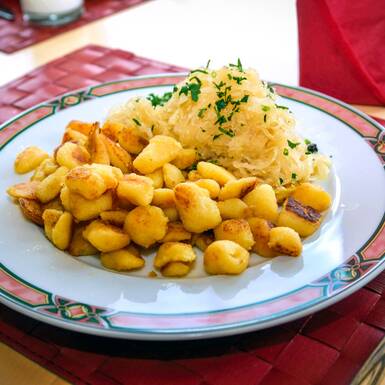- Cuisine
Maiwipfihonig
It’s all in the name, but not entirely in this case. “Maiwipfihonig” actually has nothing to do with honey produced by bees. Although it has the same golden colour, is sweet and of the same texture, it is the young spruce tips that contribute to the taste of the “Maiwipfihonig”. The name originates from the month that the light green tips sprout from the trees. The dialect for a young shoot is “Wipfi”.
Tanja Kees, the TEH herbalist from the herbal garden at the Reiteralm, reveals her recipe to make this tasty and healthy spread. “The scent of the essential oil of the spruce tips is evident as soon as you pick them”, Tanja enthuses but also cautions “The spruce tips should only be harvested in dry weather otherwise the substance becomes saturated. Ideally, the tips should be collected from the mountain forests where the active agents are more intense”. The active agents that Tanja is referring to not only have an intense scent of the forest but also acts as an expectorant, cough suppressant, has an anti-inflammatory effect and enhances circulation. For this reason, syrup and honey are often prescribed for coughs, hoarseness and a sore throat. “The Maiwipfihonig forms a protective layer on the mucous membrane of the throat and alleviates the irritation in the throat. The young tips are also full of vitamin C and vital substances. You can also pick the tips directly from the tree and have a nibble”!
The quickest way to make honey
No sooner said than done… While Tanja is gathering the tips and filling her basket, I take a nibble on a young shoot and am thrilled at how fresh and somewhat sour it tastes. When I close my eyes, I see a dense forest in front of me and hear the rustling of the trees. From one minute to the next it starts to rain, big fat drops fall from the sky, and we make a run for it back to the Reiteralm. There Tanja has prepared everything for the first of the recipes. Place two handfuls of spruce tips into a pot and pour over half a litre of cold water. “I will let the tips soak for 24 hours in the cold water. Afterwards, the cold extract will be boiled briefly and left to stand for a further 24 hours. I have already prepared something for you so that we only have to boil the extract one final time before draining.” Tanja squeezes the still hot yellow milky substance through a coarse linen cloth into a pot. She adds the brown sugar and reveals “I take one kilo of sugar per litre. The mixture must simmer for a further five to six hours until the texture is that of honey. After only approximately two hours, the mixture has turned into an amber coloured syrup. We use some of the syrup in its present form, as it tastes great in tea and can also be eaten by the spoonful. The syrup, which is still hot is poured into sterilised glass jars and sealed. The rest of the syrup is cooked until it becomes honey”.
The sunshine method
For those who would prefer to let the sun do the work, rather than stand over a hot oven can opt for the second variation of preparation. “Take a large empty sterilised pickled gherkin glass and fill with layers of green spruce tips and sugar. The layers of sugar should always be approximately one centimetre thick, covered by a layer of one and a half centimetres of bushy spruce tips. The contents of the glass should be well compressed by using a pestle and then closed and left out in the sun. On a daily basis, it is necessary to use the pestle to ensure that the contents are well compressed so that the juice comes out and fuses with the sugar. Over time, fine honey with a gooey texture will be formed without cooking”.
For those who are visiting outside the Maiwipfel season, or simply don’t feel like cooking can naturally also purchase the honey or syrup from the TEH herbal witch at the Reiteralm.
















